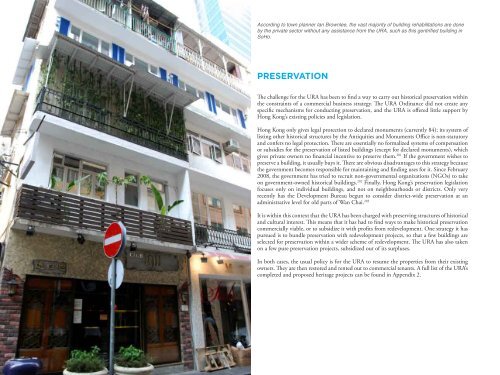Treating the Symptoms - A Critical Review of ... - Civic Exchange
Treating the Symptoms - A Critical Review of ... - Civic Exchange
Treating the Symptoms - A Critical Review of ... - Civic Exchange
- No tags were found...
Create successful ePaper yourself
Turn your PDF publications into a flip-book with our unique Google optimized e-Paper software.
According to town planner Ian Brownlee, <strong>the</strong> vast majority <strong>of</strong> building rehabilitations are doneby <strong>the</strong> private sector without any assistance from <strong>the</strong> URA, such as this gentrified building inSoHo.PreservationThe challenge for <strong>the</strong> URA has been to find a way to carry out historical preservation within<strong>the</strong> constraints <strong>of</strong> a commercial business strategy. The URA Ordinance did not create anyspecific mechanisms for conducting preservation, and <strong>the</strong> URA is <strong>of</strong>fered little support byHong Kong’s existing policies and legislation.108Hong Kong only gives legal protection to declared monuments (currently 84); its system <strong>of</strong>listing o<strong>the</strong>r historical structures by <strong>the</strong> Antiquities and Monuments Office is non-statutoryand confers no legal protection. There are essentially no formalized systems <strong>of</strong> compensationor subsidies for <strong>the</strong> preservation <strong>of</strong> listed buildings (except for declared monuments), whichgives private owners no financial incentive to preserve <strong>the</strong>m. 201 If <strong>the</strong> government wishes topreserve a building, it usually buys it. There are obvious disadvantages to this strategy because<strong>the</strong> government becomes responsible for maintaining and finding uses for it. Since February2008, <strong>the</strong> government has tried to recruit non-governmental organizations (NGOs) to takeon government-owned historical buildings. 202 Finally, Hong Kong’s preservation legislationfocuses only on individual buildings, and not on neighbourhoods or districts. Only veryrecently has <strong>the</strong> Development Bureau begun to consider district-wide preservation at anadministrative level for old parts <strong>of</strong> Wan Chai. 203It is within this context that <strong>the</strong> URA has been charged with preserving structures <strong>of</strong> historicaland cultural interest. This means that it has had to find ways to make historical preservationcommercially viable, or to subsidize it with pr<strong>of</strong>its from redevelopment. One strategy it haspursued is to bundle preservation with redevelopment projects, so that a few buildings areselected for preservation within a wider scheme <strong>of</strong> redevelopment. The URA has also takenon a few pure preservation projects, subsidized out <strong>of</strong> its surpluses.In both cases, <strong>the</strong> usual policy is for <strong>the</strong> URA to resume <strong>the</strong> properties from <strong>the</strong>ir existingowners. They are <strong>the</strong>n restored and rented out to commercial tenants. A full list <strong>of</strong> <strong>the</strong> URA’scompleted and proposed heritage projects can be found in Appendix 2.
















